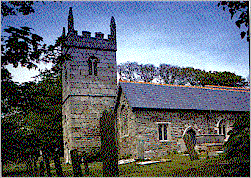

Churches in Cornwall. There is one cathedral in Cornwall, at Truro, and a large number of very old churches going right back to Norman, and even pre-Norman.
Churchyards often contain early Christian remains, such as inscribed stones,
crosses and holy wells.
The churches built earlier than 1200 were small and simple; a nave, with a south
doorway and sometimes a north doorway. Norman churches were more complex and
many Norman remains are seen within present day buildings. The Norman fonts
are especially splendid to find, with the carved heads and rosettes.
There was considerable rebuilding in the 12th and 13th centuries and many of
our present day churches have elements from this period.
The granite arches, pillars and windows of the medieval period have survived with little restoration and the medieval church towers were often faced and decorated with granite. Many churches still have the 15th and 16th century carved bench-ends and roof bosses.

Truro Cathedral - The three spired cathedral is one of the few cathedrals completed in the twentieth century in Britain. It is built in Cornish granite and Bath stone in Gothic and Early English styles
Altarnun
- The 'Cathedral in the Moor' is in a wooded valley where the lane fords Penpont
Water.
Antony - Antony Church has the most spectacular early brass in Cornwall dedicated to Lady Margery Arundell 1428.
Bodmin - Bodmin Church is the largest parish church in Cornwall and has close associations with St Petroc
Callington - This is described by Pevsner as ‘an ambitious building’. The font here is similar to the one at Altarnun.
Crantock - near Newquay - Although the outside of the church is plain, inside the carving is to a high standard.
Landrake - A 100 foot tower on the top of a hill and a Norman font similar in style to that of Altarnun.
Linkinhorne - Built completely in granite and with the second highest tower in Cornwall at 120ft.
Maryfield - This little church is in the grounds of Antony house and designed in 1865.
Morwenstow Church - is perhaps best known for its vicar/poet Robert Stephen Hawker.
North Hill - A large church in the centre of North Hill village. The chancel is 14th century and the rest was built in the late 15th to 16th cent.
Pillaton - As at Antony this church is also said to have been dedicated in 1259.
St Buryan - 13th century church on the site of earlier churches.
St Columb - St Columb Church is a fine Grade 1 listed building, at the head of the fertile Vale of Lanherne.
St Enodoc - St Enodoc Church is where John Betjemen, the former poet laureate is buried
St Erney - A small church in an lonely setting with an unusually squat tower.
St Germans - On the site of a Saxon Cathedral, bishops were recorded here from 931 to 1040.
St Just in Roseland - near St Mawes - Perhaps the loveliest setting of any church in Britain.The churchyard has wonderful views
St Piran's Oratory - Re-buried in Perran sands to protect it from the ravages of the weather and people.
St Piran's Old Church - built to replace the Oratory, and in turn abandoned in early 19th century.
St Stephen-by-Saltash - More than a mile from the town, this was the parish church of Saltash until 1881.
Sheviock - Much of this church still reveals its C13 and C14 origins, especially the tower which is unique in Cornwall having a spire.
South
Hill - This was the mother church of Callington. In the churchyard
there is a 6th or 7th century inscribed stone.
Tintagel
- A pretty little church
Torpoint - A plain church dating from 1819
Methodism in Cornwall The Methodist movement began in the eighteenth century with John Wesley and his friends visiting the area.
Cornwall Information page